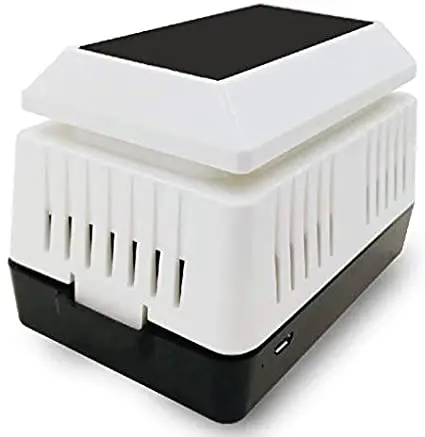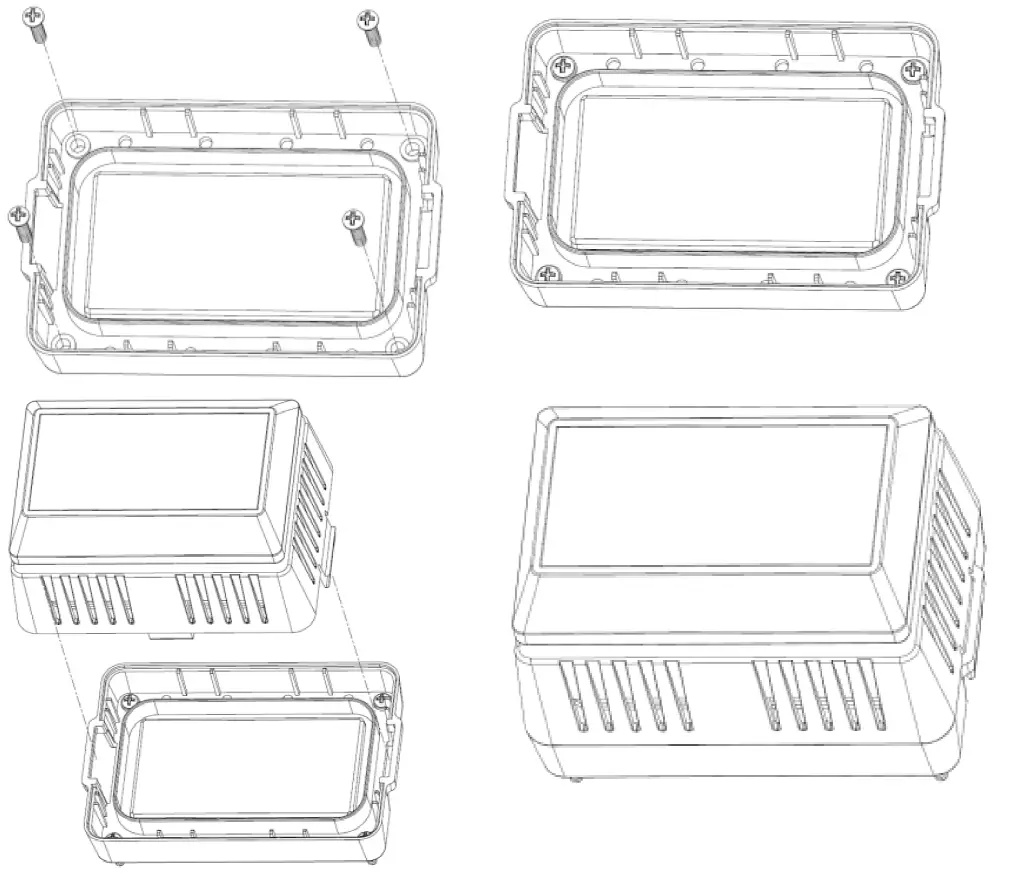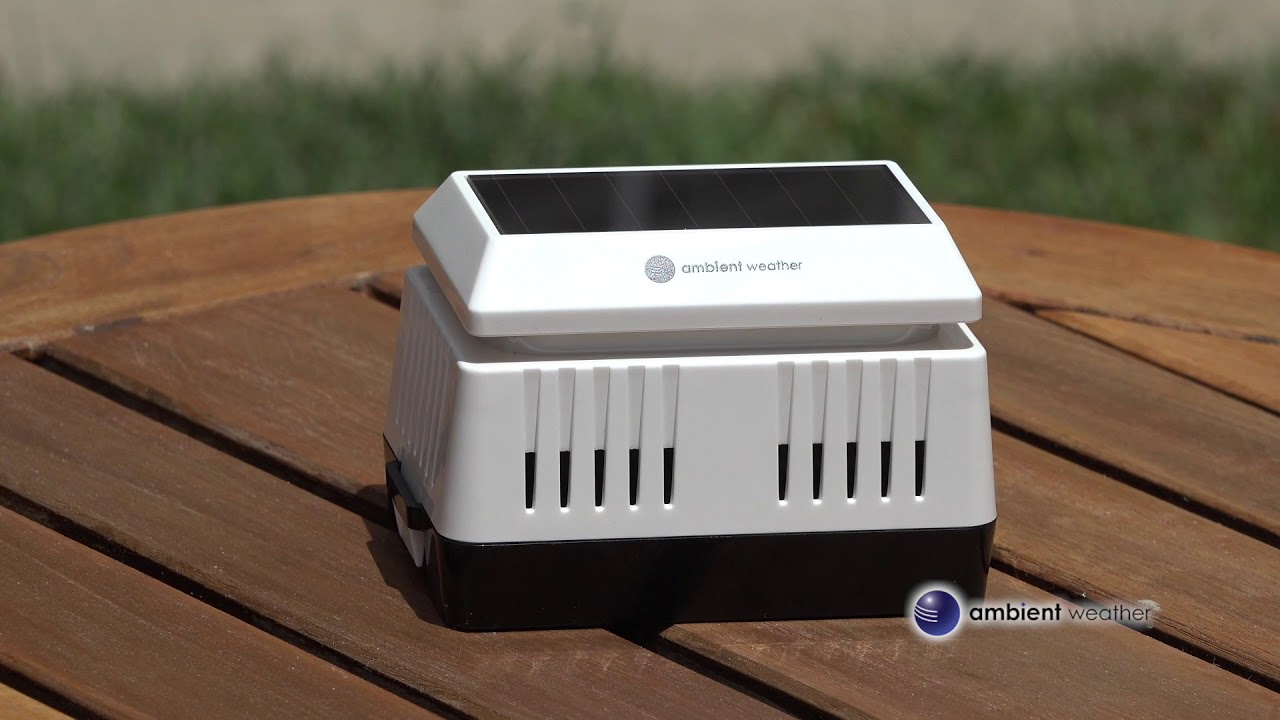ambient PM2.5 Wireless Indoor / Outdoor Particulate Monitor

Introduction
Thank you for your purchase of the Ambient Weather PM2.5 WiFi Indoor / Outdoor Particulate Monitor. The following user guide provides step by step instructions for installation, operation and troubleshooting. To download the latest manual, compatible devices, and additional troubleshooting tips, please visit: https://ambientweather.net/product/pm25
PM2.5 refers to particles that are 2.5 microns or smaller in diameter. This sensor uses laser scattering to radiate suspending particles in the air, then collects scattering light to obtain the curve of scattering light change with time. The microprocessor calculates equivalent particle diameter and the number of particles with different diameter per unit volume.
The following table describes the Air Quality Index (AQI) vs. PM2.5 breakpoints.
| AQI Category | Breakpoints (µg/m3) |
| Good | 0.0 – 12.0 |
| Moderate | 12.1 – 35.4 |
| Unhealthy for Sensitive Groups | 35.5 – 55.4 |
| Unhealthy | 55.5 – 150.4 |
| Very Unhealthy | 150.5 – 250.4 |
| Hazardous | 250.5 – 350.4 |
| Extremely Hazardous | 350.5 – 500 |
Parts List
| QTY | Item |
| 1 | PM2.5 Sensor |
| 1 | USB Charging Cable |
| 2 | Ni-MH Rechargeable Batteries |
| 4 | Mounting Screws |
| 1 | User manual |
Recommend Tools
Precision screwdriver for mounting screws.
Warning: Only use Ni-MH Rechargeable Batteries. Do not use any other battery chemistry. Using batteries other than the prescribed Ni-MH may result in battery explosion when charging.
Sensor Overview

| No | Description | No | Description |
| 1 | Solar Collector | 4 | Blue LED Indicator (charging status) |
| 2 | Battery Compartment Cover | 5 | USB Charging Port |
| 3 | Red LED Indicator (RF transmission) | 6 | Battery Compartment |
Sensor Setup
Inserting the Batteries
Remove the battery cover on the bottom of the sensor, and insert the 2 x AA Ni-MH Rechargeable Batteries.After inserting the batteries, the sensor LED indicator will light for four seconds, and then flash once per 10 minutes thereafter. Each time it flashes, the sensor is transmitting data.Close the battery door.
Recharging the Batteries
When there is no solar energy, a fully charged set of batteries can last for about 20 days (approximately 500 hours). A low battery indicator will appear on the display console.To recharge the batteries:
- Remove the battery cover on the bottom of the sensor.
- Connect the USB cable to a standard USB power adapter and charge battery until blue LED turns off, indicating batteries are fully charged.
- Once charged, disconnect the USB charging cable.
- Close the battery door.
Sensor Installation
Sensor Mounting
Mounting GuidelinesPlace the sensor in a shaded, well ventilated, non-moisture condensing area. Although the sensor is designed for outdoor use, it is best to mount in a well protected area, such as under a patio or carport.The solar panel is sensitive to low light, but will still require monthly charging from the USB power port.With PM2.5 sensors, fog reflects the light, and can result in a higher reading. This is characteristic to the inherent sensor design. The condition occurs during rainy or foggy weather.Mounting orientation is not important. It can be mounted vertically or horizontally, as long as the vents are not blocked.
Mounting ScrewsOpen the battery compartment.Use four screws to fix the base of the sensor on a flat surface.Close the battery compartment.

Best Practices for Wireless Communication
Wireless communication is susceptible to interference, distance, walls and metal barriers. We recommend the following best practices for trouble free wireless communication.
- Electro-Magnetic Interference (EMI). Keep the console several feet away from computer monitors and TVs.
- Radio Frequency Interference (RFI). If you have other 915 MHz devices and communication is intermittent, try turning off these other devices for troubleshooting purposes. You may need to relocate the transmitters or receivers to avoid intermittent communication.
- Line of Sight Rating. This device is rated at 300feet line of sight (no interference, barriers or walls) but typically you will get 100feet maximum under most real-world installations, which include passing through barriers or walls.
- Metal Barriers. Radio frequency will not pass through metal barriers such as aluminum siding. If you have metal siding, align the remote and console through a window to get a clear line of sight. The following is a table of reception loss vs. the transmission medium. Each “wall” or obstruction decreases the transmission range by the factor shown below.
| Medium | RF Signal Strength Reduction |
| Glass (untreated) | 5-15% |
| Plastics | 10-15% |
| Wood | 10-40% |
| Brick | 10-40% |
| Concrete | 40-80% |
| Metal | 90-100% |
Specifications
Measurement Specifications
| Measurement | Range | Accuracy | Resolution |
| PM 2.5 | 0~999ug/m3 | >100ug/m3, ±15%
<100ug/m3, ±15ug/m3 (at 25°C ±5°C) |
1ug/m3 |
Wireless Specifications Transmission distance in open field: 300 feet line of sight, 100 feet under most conditions.Frequency: 915 MHzSensor reporting interval: 10 minutes
Power SpecificationsPM2.5 sensor: 2 x AA 1.2V LSD type NI-MH batteries (included) Solar panel for backup power
High Moisture LimitationsWith PM2.5 sensors, fog reflects the light, and can result in a higher reading. This is characteristic to the inherent sensor design.The condition occurs during rainy or foggy weather, where:
Outdoor Temperature – Dew point Temperature ≤ 2º C (3.6 ºF)
Thus, when the air is nearly saturated, the data is invalid.Do your best to mount the sensor in a well-drained area which is less prone to moisture condensation if possible.
Maintenance
We recommend cleaning the fan every few months, or when readings appear to not change.For more information, please visit: https://ambientweather.net/help/mounting-guidelines-and-maintenance/
Liability Disclaimer
Please help in the preservation of the environment and return used batteries to an authorized depot. The electrical and electronic wastes contain hazardous substances. Disposal of electronic waste in wild country and/or in unauthorized grounds strongly damages the environment.Reading the “User manual” is highly recommended. The manufacturer and supplier cannot accept any responsibility for any incorrect readings and any consequences that occur should an inaccurate reading take place.This product is designed for use in the home only as indication of weather conditions. This product is not to be used for medical purposes or for public safety information.The specifications of this product may change without prior notice.This product is not a toy. Keep out of the reach of children.No part of this manual may be reproduced without written authorization of the manufacturer.Ambient, LLC WILL NOT ASSUME LIABILITY FOR INCIDENTAL, CONSEQUENTIAL, PUNITIVE, OR OTHER SIMILAR DAMAGES ASSOCIATED WITH THE OPERATION OR MALFUNCTION OF THIS PRODUCT.
FCC Statement
Statement according to FCC part 15.19:This device complies with part 15 of the FCC rules. Operation is subject to the following two conditions:
- This device may not cause harmful interference.
- This device must accept any interference received, including interference that may cause undesired operation.
Statement according to FCC part 15.21:Modifications not expressly approved by this company could void the user’s authority to operate the equipment.
Statement according to FCC part 15.105:NOTE: This equipment has been tested and found to comply with the limits for a Class B digital device, pursuant to Part 15 of the FCC Rules. These limits are designed to provide reasonable protection against harmful interference in a residential installation. This equipment generates, uses and can radiate radio frequency energy and, if not installed and used in accordance with the instructions, may cause harmful interference to radio communications.However, there is no guarantee that interference will not occur in a particular installation. If this equipment does cause harmful interference to radio or television reception, which can be determined by turning the equipment off and on, the user is encouraged to try to correct the interference by one or more of the following measures:
- Reorient or relocate the receiving antenna.
- Increase the separation between the equipment and receiver.
- Connect the equipment into an outlet on a circuit different from that to which the receiver is connected.
- Consult the dealer or an experienced radio/TV technician for help.
Warranty Information
Ambient, LLC provides a 1-year limited warranty on this product against manufacturing defects in materials and workmanship.This limited warranty begins on the original date of purchase, is valid only on products purchased and only to the original purchaser of this product. To receive warranty service, the purchaser must contact Ambient, LLC for problem determination and service procedures.Warranty service can only be performed by a Ambient, LLC. The original dated bill of sale must be presented upon request as proof of purchase to Ambient, LLC.Your Ambient, LLC warranty covers all defects in material and workmanship with the following specified exceptions: (1) damage caused by accident, unreasonable use or neglect (lack of reasonable and necessary maintenance); (3) damage resulting from failure to follow instructions contained in your owner’s manual; (4) damage resulting from the performance of repairs or alterations by someone other than an authorized Ambient, LLC authorized service center; (5) units used for other than personal use (6) applications and uses that this product was not intended (7) the products inability to receive a signal due to any source of interference or metal obstructions and (8) extreme acts of nature, such as lightning strikes or floods.This warranty covers only actual defects within the product itself, and does not cover the cost of installation or removal from a fixed installation, normal set-up or adjustments, claims based on misrepresentation by the seller or performance variations resulting from installation-related circumstances.
California Prop 65
WARNING: Use of the Ambient Weather Products can expose you to chemicals, including lead and lead compounds, which are known to the State of California to cause cancer and bisphenol A (BPA), and phthalates DINP and/or DEHP, which are known to the State of California to cause birth defects or other reproductive harm.
California maintain and publish a list of chemicals that are known to cause cancer, birth defects and/or other reproductive harm. The Prop 65 list, which must be updated annually, includes over 1,000 chemicals, including many that are commonly used in the electronics industry.
Although our manufacturing process is “lead-free” and RoHS compliant, it remains possible that trace amounts of lead could be found in components or subassemblies of Ambient Weather Products. Bisphenol A (BPSA) could conceivably be present in minute amounts in our plastic housings, lenses, labels or adhesives, and DEHP & DINP (phthalates) could possibly be found in PVC wire coatings of our cables, housings, and power cords. Unlike RoHS, Prop 65 does not establish a specific threshold for reporting on the substances of concern and instead sets forth a much less definitive standard requiring that the business demonstrate with certainty that there is “no significant risk” resulting from exposure. With respect to carcinogens, the “no significant risk” level is defined as the level which is calculated to result in not more than one excess case of cancer in 100,000 individuals exposed over a 70-year lifetime. In other words, if you are exposed to the chemical in question at this level every day for 70 years, theoretically, it will increase your chances of getting cancer by no more than 1 case in 100,000 individuals so exposed. With respect to reproductive toxicants, the “no significant risk” level is defined as the level of exposure which, even if multiplied by 1,000, will not produce birth defects or other reproductive harm. In other words, the level of exposure is below the “no observable effect level,” divided by 1,000. (The “no observable effect level” is the highest dose level which has not been associated with observable reproductive harm in humans or test animals.) Proposition 65 does not clarify whether exposure is to be measured only in normal operation, or in the event of misuse such as intentionally damaging, incinerating or consuming an Ambient Weather Product or component and Ambient Weather has not attempted to evaluate the level of exposure.
A Proposition 65 warning means one of two things: (1) the business has evaluated the exposure and has concluded that it exceeds the “no significant risk level”; or (2) the business has chosen to provide a warning simply based on its knowledge about the presence of a listed chemical without attempting to evaluate the exposure. The California government has itself clarified that “The fact that a product bears a Proposition 65 warning does not mean by itself that the product is unsafe.” The government has also explained, “You could think of Proposition 65 more as a ‘right to know’ law than a pure product safety law.”
While using Ambient Weather Products as intended, we believe any potential exposure would be negligible or well within the “no significant risk” range. However, to ensure compliance with California law and our customers’ right to know, we have elected to place the Proposition 65 warning signs on Ambient Weather Products.
For further information about California’s Proposition 65, please visit https://oehha.ca.gov/prop65/background/p65plain.html

References
[xyz-ips snippet=”download-snippet”]


